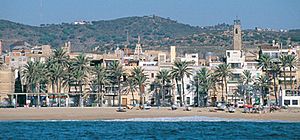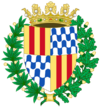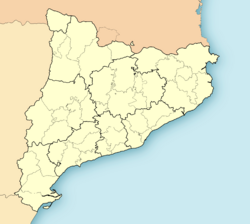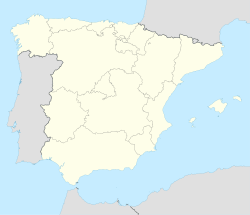Badalona facts for kids
Quick facts for kids
Badalona
|
|||
|---|---|---|---|
|
Municipality
|
|||
 |
|||
|
|||

Location in Barcelonès county
|
|||
| Sovereign state | |||
| Community | |||
| Region | Barcelona | ||
| County | Barcelonès | ||
| Province | Barcelona | ||
| Area | |||
| • Total | 21.2 km2 (8.2 sq mi) | ||
| Elevation | 12 m (39 ft) | ||
| Population
(2018)
|
|||
| • Total | 217,741 | ||
| • Density | 10,271/km2 (26,600/sq mi) | ||
| Demonyms | Badalonian (en) Badaloní; Badalonina (ca) Badalonés; Badalonesa (es) |
||
| Postal code |
08910-08918
|
||
| Area code(s) | (+34) 934 | ||
| Climate | Csa | ||
Badalona is a lively city in Catalonia, Spain. It's located northeast of Barcelona, right by the Mediterranean Sea. Badalona is the third largest city in Catalonia by population. It became an official city in 1897.
Contents
What's in a Name?
The name Badalona comes from an ancient Iberian word, Baitolo. This word was found on old bronze coins. The Romans later called their new city Baetulo.
Over time, the name changed. During the Middle Ages, people used names like Bitulona or Bedalona. The name Badalona became common around the year 997. By the 14th century, it was the name everyone used.
A Look Back: History of Badalona
Early Settlements
People have lived in the Badalona area for a very long time. The oldest signs of people are from the Neolithic period, about 3,500 to 2,500 years BC. Tools made of stone and flint have been found. Tombs with ancient items were also discovered. Later, people lived here during the Bronze Age and Iron Age.
Before the Romans arrived, the Iberians lived on Boscà hill. They could see the coastline from there. This settlement was active from at least the 4th century BC.
Roman Times
Badalona's story really begins around 100 BC. This is when the Romans built a new city called Baetulo. It was located on Rosés hill, near the coast. The Roman city was well-planned, like many Roman towns. It covered about 10 hectares and had strong walls.
Baetulo was a busy city, especially during the time of Emperor Augustus. They grew grapes and made wine to sell all over the Roman Empire. After the 3rd century, the city became less important. Many people moved to country farms. But Baetulo was never completely empty.
Medieval and Modern Growth
The current city of Badalona started to form in the 10th century. A new town grew over the old Roman city. The old Roman temple became a church. For a long time, Badalona was a mix of town and countryside.
The Sant Jeroni de la Murtra Monastery was built in the 14th century. Important rulers, like the Catholic Monarchs, used to spend their summers there. Some say that Christopher Columbus met them there after his first trip to the Americas.
Industrial Revolution and City Status
In the early 1800s, Badalona was mostly a farming and fishing town. But everything changed in 1848. A railway line was built connecting Mataró and Barcelona, and Badalona got a train station. This helped the city grow quickly. Factories started to appear, and the economy changed.
Many people moved to Badalona for work. The population grew from about 5,700 people in 1851 to nearly 10,500 in 1857. By the end of the 1800s, there were about 19,000 people. This growth led to new neighborhoods being built along the coast. In 1897, Badalona officially became a city.
Challenges and Transformation
In the early 20th century, Badalona continued to grow fast. New neighborhoods were built, but they sometimes lacked good roads or services. During the dictatorship of Primo de Rivera, the city tried to improve things. They built new schools, markets, and sewage systems.
During the Spanish Civil War, Badalona was bombed because it was an important industrial center. After the war, during Franco's dictatorship, many people moved to Badalona, especially from southern Spain. The city's population grew from 92,200 in 1960 to over 200,000 just 15 years later. This rapid growth led to some areas having difficult living conditions.
After Franco's rule ended in 1975, Badalona saw a new energy. People in neighborhoods worked together to improve their city. They fought for better services and urban spaces. Badalona also changed from a factory-based economy to one focused on services.
In 1992, Badalona was a host city for the 1992 Summer Olympics. It held the basketball and boxing events. Even though it's close to Barcelona, Badalona has its own unique identity.
Weather in Badalona
Badalona has a warm Mediterranean climate. This means it has hot, dry summers and mild, wet winters.
| Climate data for Badalona | |||||||||||||
|---|---|---|---|---|---|---|---|---|---|---|---|---|---|
| Month | Jan | Feb | Mar | Apr | May | Jun | Jul | Aug | Sep | Oct | Nov | Dec | Year |
| Mean daily maximum °C (°F) | 13.7 (56.7) |
14.1 (57.4) |
15.7 (60.3) |
17.4 (63.3) |
20.2 (68.4) |
23.7 (74.7) |
26.8 (80.2) |
27.9 (82.2) |
24.8 (76.6) |
21.5 (70.7) |
17.2 (63.0) |
14.4 (57.9) |
19.8 (67.6) |
| Daily mean °C (°F) | 10.1 (50.2) |
10.7 (51.3) |
12.5 (54.5) |
14.2 (57.6) |
17.4 (63.3) |
21.3 (70.3) |
24.3 (75.7) |
25.0 (77.0) |
21.8 (71.2) |
18.3 (64.9) |
13.7 (56.7) |
11.0 (51.8) |
16.7 (62.1) |
| Mean daily minimum °C (°F) | 6.7 (44.1) |
7.2 (45.0) |
9.3 (48.7) |
11.0 (51.8) |
14.6 (58.3) |
18.6 (65.5) |
21.7 (71.1) |
21.8 (71.2) |
18.8 (65.8) |
15.1 (59.2) |
10.3 (50.5) |
7.6 (45.7) |
13.6 (56.5) |
| Average precipitation mm (inches) | 43.8 (1.72) |
36.3 (1.43) |
36.3 (1.43) |
41.8 (1.65) |
49.7 (1.96) |
37.2 (1.46) |
25.2 (0.99) |
49.3 (1.94) |
78.4 (3.09) |
80.9 (3.19) |
54.4 (2.14) |
41.2 (1.62) |
575 (22.6) |
| Average precipitation days (≥ 0.1 mm) | 7.8 | 7.3 | 7.5 | 8.7 | 7.6 | 4.4 | 3.8 | 4.8 | 7.0 | 6.7 | 6.5 | 4.0 | 76 |
| Average relative humidity (%) | 67 | 65 | 69 | 72 | 73 | 72 | 73 | 73 | 72 | 73 | 69 | 68 | 70 |
| Source: MeteoBDN (1981–2010, 2009–2017 for precipitation days and humidity) | |||||||||||||
How Badalona is Organized
Badalona is divided into 34 neighborhoods and 6 larger districts. This system helps manage the city as it grew. The current division was set up in 1980 and updated in 2011.
Here are the districts and some of their neighborhoods:
- District 1: Canyadó, Casagemes, Centre, Coll i Pujol, Dalt de la Vila, El Manresà and El Progrés.
- District 2: Montigalà (western part), Nova Lloreda, Sant Crist de Can Cabanyes, Sistrells, La Pau and Puigfred.
- District 3: Montigalà (eastern part), Canyet, Mas Ram, Bufalà, Pomar, Pomar de Dalt, Bonavista, Les Guixeres and Morera.
- District 4: La Salut, Sant Antoni de Llefià, Sant Joan de Llefià, Sant Mori de Llefià.
- District 5: Gorg, La Mora, Congrés, Can Claris and El Raval.
- District 6: Artigues, El Remei and Sant Roc.
Getting Around Badalona
Badalona has good transportation links. You can use the Renfe train (R1 line) to travel to Barcelona or other towns. The city also has a harbor.
For getting around the city and to Barcelona, you can use the Barcelona Metropolitan Transport (TMB) metro (underground train) and bus system. There's also the Trambesòs line, which is a tram.
People of Badalona
Badalona is a diverse city. It has many residents from different countries. The largest groups of foreign residents are from Morocco and Pakistan. There are also significant communities from China, Ecuador, Bolivia, India, Senegal, and the Dominican Republic.
| Largest groups of foreign residents | |
| Nationality | Population (2011) |
|---|---|
| Morocco | 5,527 |
| Pakistan | 5,462 |
| China | 3,835 |
| Ecuador | 3,062 |
| Bolivia | 1,800 |
| India | 1,305 |
| Senegal | 1,222 |
| Dominican Republic | 1,000 |
Badalona's Economy
Badalona's economy mostly relies on the service sector today. This means jobs in areas like shops, restaurants, and tourism. In the past, it was a big industrial center with many factories. Farming and fishing were also important long ago, but these activities have become much smaller.
In 2017, most of Badalona's economic activity (almost 80%) came from services. Industry made up about 13%, and construction about 7%. Farming and fishing were very small parts of the economy.
Farming and Fishing
Today, farming in Badalona mainly involves vineyards. These vineyards are located near the Can Coll farm and the Sant Jeroni de la Murtra monastery. Badalona is part of the Alella DO, which is a special wine region.
Fishing is also a very small part of the economy now. For a long time, Badalona didn't have its own port, so fishers had to go to other cities. A new port opened in 2005. It's mostly for boats, but it also has a fishing area and a fish market.
Industry and Business
Industry was very important in Badalona for many years, especially after the train arrived in 1848. Many factories for chemicals, metals, food, and drinks were built. However, in the late 20th century, many industries moved away.
Since then, Badalona has developed special industrial zones. One example is Les Guixeres, where the Badalona International Business Center was built. This center aims to help local companies grow and connect with businesses in Europe and America. Key industries now include microelectronics, robotics, packaging, and textile machinery.
Culture and Festivities
In May, Badalona celebrates its patron saint, Saint Anastasi. Many fun activities and festivals happen all over the city. The most exciting event is the Cremada del Dimoni (Devil-Burning). This takes place the night before Saint Anastasi Day. People gather by the sea to watch a giant devil figure burn. It's similar to the famous Falles festival in Valencia. During these celebrations, the large, traditional Badalona giants are also shown.
Visiting Badalona
Badalona is a popular place for tourists to visit. The city has a special route that takes you through the old town, called Dalt de la Vila. You can see the Church of Santa Maria, the Old Tower, and charming medieval streets. There are also some beautiful modernist houses.
From there, you can explore the Baix a Mar or Centre area. This part of the city has many shops, restaurants, bars, and cafes.
Here are some top places to visit:
- The Sant Jeroni de la Murtra Monastery.
- The old Roman city of Baetulo, which you can explore at the Badalona Museum.
- The ancient Iberian settlement on turó d'en Boscà hill.
- The city's beautiful beach.
- The exciting annual Burning of the Devil during the May Festivities.
Sports in Badalona
The most important sports building in Badalona is the Palau Municipal d'Esports de Badalona (Municipal Sports Palace). This amazing building won an award in 1992. It was used for the basketball games during the 1992 Olympic Games.
Today, it's the home court for Badalona's basketball team, Joventut Badalona, also known as la Penya. There are plans for this area to become the "Badalona European Basketball Capital." This would be a theme park celebrating basketball, with a museum, shops, cinemas, basketball courts, and more!
Sister Cities
Badalona has special friendships with other cities around the world. These are called "twin towns" or "sister cities."
- Alcanar, Spain
- San Fernando, Spain
- Parla, Spain
- Valparaíso, Chile
- Gothenburg, Sweden
- Sitges, Spain
Famous People from Badalona
Many talented people come from Badalona! Here are a few:
- Llorenç Brunet (1873–1939), an illustrator.
- Joan Amigó (1875–1959), an architect.
- Lluïsa Cunillé (born 1961), a playwright.
- Jordi Dauder (1938–2011), an actor.
- Julià de Jòdar (born 1942), a writer.
- Enric Juliana (born 1956), a journalist.
- Daniel Sirera (born 1967), a politician.
- Jorge Javier Vázquez (born 1970), a TV personality.
- Melani Olivares (born 1973), an actress.
- Juan Magán (born 1978), a DJ and singer.
- Isaac Sánchez "Loulogio" (born 1983), a comedian.
- Pau Ribas (born 1987), a basketball player.
- Cristina Agüera Gago (born 1990), a politician.
- Mireia Belmonte (born 1990), a swimmer.
- Luis Garcia (footballer, born 1978), a former Liverpool F.C. player.
- Héctor Bellerín (born 1995), a football player.
Images for kids
See also
 In Spanish: Badalona para niños
In Spanish: Badalona para niños











